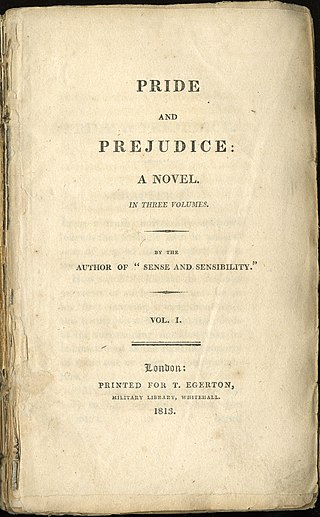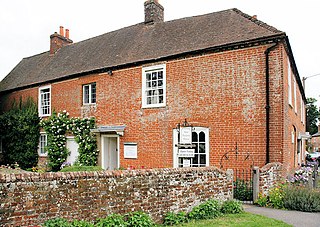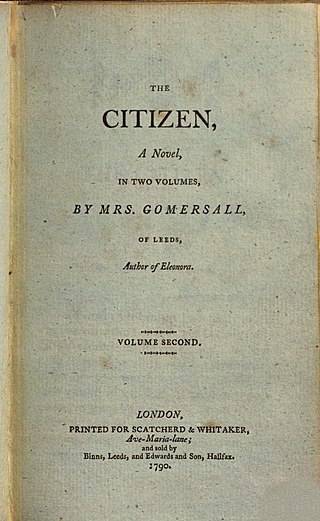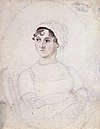
Jane Austen was an English novelist known primarily for her six novels, which implicitly interpret, critique, and comment upon the British landed gentry at the end of the 18th century. Austen's plots often explore the dependence of women on marriage for the pursuit of favourable social standing and economic security. Her works are an implicit critique of the novels of sensibility of the second half of the 18th century and are part of the transition to 19th-century literary realism. Her deft use of social commentary, realism and biting irony have earned her acclaim among critics and scholars.

Pride and Prejudice is the second novel by English author Jane Austen, published in 1813. A novel of manners, it follows the character development of Elizabeth Bennet, the protagonist of the book, who learns about the repercussions of hasty judgments and comes to appreciate the difference between superficial goodness and actual goodness.

Alton is a market town and civil parish in East Hampshire, England, near the source of the northern branch of the River Wey. It had a population of 17,816 at the 2011 census.

Chawton is a village and civil parish in the East Hampshire district of Hampshire, England. The village lies within the South Downs National Park and is famous as the home of Jane Austen for the last eight years of her life.

Elizabeth Inchbald was an English novelist, actress, dramatist, and translator. Her two novels, A Simple Story and Nature and Art, have received particular critical attention.
Sandy Lerner is an American businesswoman and philanthropist. She co-founded Cisco Systems, and used the money from its sale to pursue interests in animal welfare and women's writing. One of her main projects, Chawton House, is in England, but most of her work remains in the United States.

Steventon is a village and a civil parish with a population of about 250 in north Hampshire, England. Situated 7 miles south-west of the town of Basingstoke, between the villages of Overton, Oakley and North Waltham, it is close to Junction 7 of the M3 motorway.

Farringdon is a civil parish in the East Hampshire district of Hampshire, England. It is 2.8 miles (4.5 km) south of Alton, on the A32 road, close to a source of the River Wey.
Mary Hays (1759–1843) was an autodidact intellectual who published essays, poetry, novels and several works on famous women. She is remembered for her early feminism, and her close relations to dissenting and radical thinkers of her time including Robert Robinson, Mary Wollstonecraft, William Godwin and William Frend. She was born in 1759, into a family of Protestant dissenters who rejected the practices of the Church of England. Hays was described by those who disliked her as 'the baldest disciple of [Mary] Wollstonecraft' by The Anti Jacobin Magazine, attacked as an 'unsex'd female' by clergyman Robert Polwhele, and provoked controversy through her long life with her rebellious writings. When Hays's fiancé John Eccles died on the eve of their marriage, Hays expected to die of grief herself. But this apparent tragedy meant that she escaped an ordinary future as wife and mother, remaining unmarried. She seized the chance to make a career for herself in the larger world as a writer.

Cassandra Elizabeth Austen was an amateur English watercolourist and the elder sister of Jane Austen. The letters between her and Jane form a substantial foundation to scholarly understanding of the life of the novelist.

Jane Austen lived her entire life as part of a family located socially and economically on the lower fringes of the English gentry. The Rev. George Austen and Cassandra Leigh, Jane Austen's parents, lived in Steventon, Hampshire, where Rev. Austen was the rector of the Anglican parish from 1765 until 1801. Jane Austen's immediate family was large and close-knit. She had six brothers—James, George, Charles, Francis, Henry, and Edward—and a beloved older sister, Cassandra. Austen's brother Edward was adopted by Thomas and Elizabeth Knight and eventually inherited their estates at Godmersham, Kent, and Chawton, Hampshire. In 1801, Rev. Austen retired from the ministry and moved his family to Bath, Somerset. He died in 1805 and for the next four years, Jane, Cassandra, and their mother lived first in rented quarters and then in Southampton where they shared a house with Frank Austen's family. During these unsettled years, they spent much time visiting various branches of the family. In 1809, Jane, Cassandra, and their mother moved permanently into a large "cottage" in Chawton village that was part of Edward's nearby estate. Austen lived at Chawton until she moved to Winchester for medical treatment shortly before her death in 1817.

Jane Austen's House Museum is a small independent museum in the village of Chawton near Alton in Hampshire. It is a writer's house museum occupying the 17th-century house in which novelist Jane Austen spent the last eight years of her life, during which time she wrote, revised and made ready to be published all six of her novels, and the fragment Sanditon. The museum has been a Grade I listed building since 1963.
Wyndham William Knight, known in some sources as Wiliam Wyndham Knight, was an English amateur cricketer who played in one first-class cricket match for Kent County Cricket Club in 1862.
Edward Knight was the nephew of Jane Austen and an English amateur cricketer who played first-class cricket from 1822 to 1828.

Edward Austen Knight was the third eldest brother of Jane Austen, and provided her with the use of a cottage in Chawton where she lived for the last years of her life. He was also High Sheriff of Kent in 1801.

Reading Abbey Girls' School, also known as Reading Ladies’ Boarding School, was an educational establishment in Reading, Berkshire open from at least 1755 until 1794. Many of its pupils went on to make a mark on English culture and society, particularly as writers. Most famous is Jane Austen, who used the school as a model of "a real, honest, old-fashioned Boarding-school".

Ann Gomersall was a British novelist of the Romantic-era who paid close attention to economic and social issues in her writing.
Anne Sharp was an English governess and teacher who worked for Edward Austen Knight's family at Godmersham Park and became a close friend of Edward's sister, the writer Jane Austen.
Frances Catherine Austen Knight, Lady Knatchbull, later Lady Knatchbull, more commonly known as Fanny Knight, was the eldest niece and correspondent of the novelist Jane Austen. Her recollections, in the form of letters and diaries, have been an important source for students of her aunt's life and work.



















